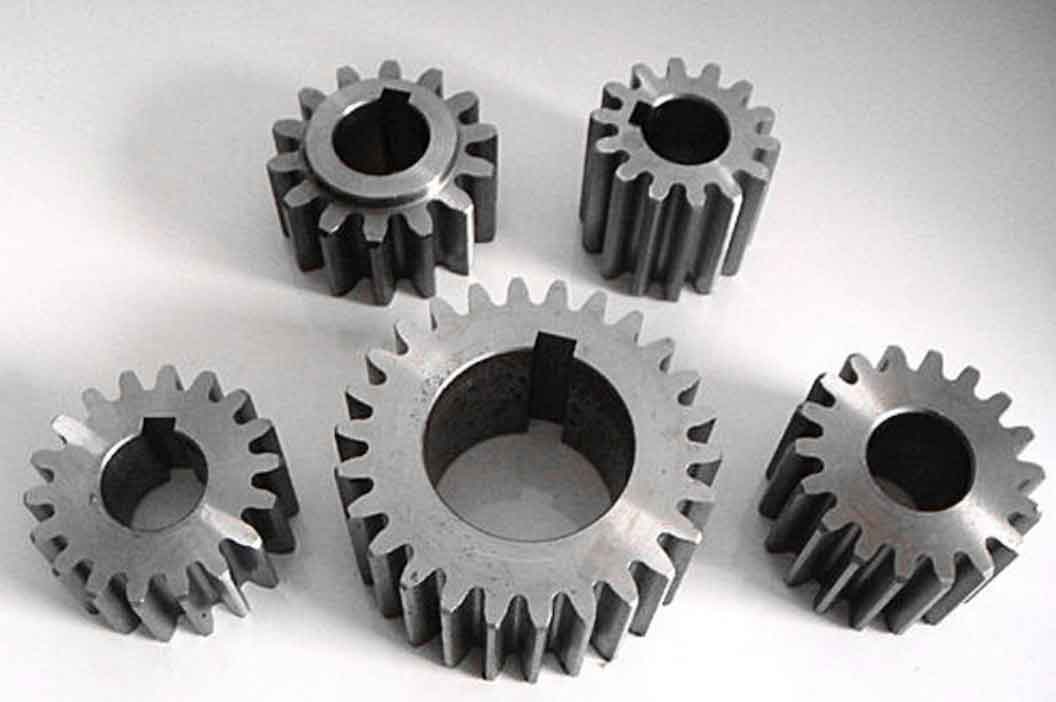
When designing and manufacturing spur gears, the selection of materials is critical due to the direct impact on performance, durability, and application suitability. Here’s a comparative study of advanced materials commonly used in spur gear manufacturing:
1. Steel Alloys
Common Types: AISI 4340, AISI 4140, and AISI 8620 Advantages:
- High Strength and Toughness: Steel alloys offer excellent mechanical properties, which can be further enhanced through heat treatments like case hardening.
- Good Wear Resistance: Suitable for high-load applications, steel gears exhibit superior wear resistance, prolonging their operational life.
- Cost-Effectiveness: Comparatively less expensive than some exotic materials, making them suitable for a wide range of industrial applications.
Disadvantages:
- Weight: Heavier than materials like aluminum or polymers, potentially affecting the efficiency of the gear system.
- Corrosion Vulnerability: Requires protective coatings or treatments in corrosive environments.
2. Stainless Steel
Common Types: AISI 304, AISI 316 Advantages:
- Corrosion Resistance: Offers excellent resistance to rust and corrosion, ideal for food processing and marine applications.
- Hygienic: Does not harbor bacteria, crucial for medical and food applications.
- Aesthetic Appeal: Maintains a high-quality surface finish.
Disadvantages:
- Cost: Generally more expensive than regular steel alloys.
- Lower Load Carrying Capacity: Compared to high-strength steel alloys, some stainless steels have lower strength and are not suitable for high-load applications.
3. Titanium Alloys
Common Types: Ti-6Al-4V Advantages:
- High Strength-to-Weight Ratio: Extremely strong yet lightweight, suitable for aerospace and automotive applications.
- Corrosion Resistance: Excellent performance in corrosive environments.
- Temperature Resistance: Maintains strength at high temperatures.
Disadvantages:
- Cost: Significantly more expensive, which can be prohibitive for general applications.
- Machining Difficulty: Requires specialized equipment and techniques, increasing spur gear manufacturing costs.
4. Polymers and Composite Materials
Common Types: Nylon, Polyacetal, Carbon Fiber Reinforced Polymer (CFRP) Advantages:
- Lightweight: Much lighter than metals, reducing overall system weight.
- Corrosion Resistance: Naturally resistant to corrosion, eliminating the need for additional treatments.
- Noise Reduction: Tend to operate more quietly than metal gears.
Disadvantages:
- Lower Temperature Tolerance: Typically not suitable for high-temperature applications.
- Wear Resistance: Generally lower than metals, though this can be mitigated with fillers and reinforcements.
5. Ceramic Materials
Common Types: Silicon Nitride, Zirconia Advantages:
- Wear Resistance: Exhibits exceptional wear resistance and maintains sharpness of features.
- Temperature and Corrosion Resistance: Performs well in high-temperature environments and against corrosive agents.
- Lightweight: Lighter than steels, beneficial for reducing operational load.
Disadvantages:
- Brittleness: Despite their hardness, ceramics can be brittle and susceptible to fracture under shock loads.
- Cost and Machining: High material and manufacturing costs, with complex machining requirements.
Comparative Analysis
When choosing materials for spur gears, the decision largely depends on the specific requirements of the application, including load, speed, environment, and cost constraints. For example:
- Aerospace Applications: Titanium alloys or CFRPs are preferred for their strength-to-weight ratios.
- Food Processing and Marine Applications: Stainless steel or certain polymers are chosen for their corrosion resistance and hygienic properties.
- High Load Industrial Applications: Hardened steel alloys are favored for their durability and cost-effectiveness.
In summary, the advancement in material science continues to expand the options available for spur gear manufacturing, allowing engineers to tailor gear systems more precisely to their specific application needs. Each material presents a set of properties that can be advantageously utilized or may pose limitations depending on the operational requirements and environmental conditions.
